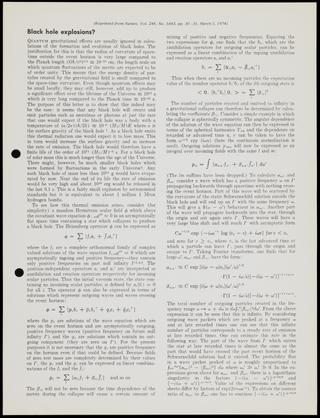
Scientific Publication: 'Spectrum of Wormholes'
- Made:
- 1990 in Suffolk county




Publication: ‘Spectrum of Wormholes’. Offprint from: Physical Review D, Vol. 42, No. 8, pp.2655-2663. [Brookhaven, NY: The American Physical Society,] 15 October 1990. Single-article booklet.
From early in his career, Hawking showed a daring approach and a flair for communication. His 1966 PhD thesis provided crucial support for the big-bang theory. Hawking ran the theory of the collapse that forms black holes in reverse, showing that the universe must explode into being from a single point in space and time.
His 1974 paper ‘Black Hole Explosions’ disproved the conventional notion that nothing could ever escape from a black hole. It boldly blended quantum theory, which describes the very small scales of the atomic world, with general relativity, the large-scale theory of gravity.
The 1981 paper on the boundary conditions of the universe is an example from his work in the 1980s called the 'no boundary proposal' of James Hartle and Stephen Hawking. This was an attempt at explaining how the Universe could arise out of nothingness, applying quantum mechanics' uncertainty principle at the beginning of time. Hawking's early results were presented at a conference attended by many of the world;s prominent cosmologists hosted by the Vatican's Pontifical Academy of Sciences, which is also the issuer of the proceedings that displayed here.
The publication 'Spectrum of Wormholes' highlights Hawking's influence on the scientific exploration of what has become one of Science Fiction's most popular themes: Wormholes. Astrophysically, wormholes were a necessity to take account of the Information Paradox. Where does information go after it has been swallowed by a black hole? Even if one waits until the black hole has evaporated due to Hawking Radiation, this radiation does not emit information, as it is what is called 'blackbody radiation'.
Wormholes in their narrow scientific sense would be mechanisms by which black holes connect to some other location in spacetime where the lost information reemerges.
Today, as back in the 1980s, wormholes are considered highly speculative by the majority of physicists and no observed astrophysical phenomena has been traced back to them.
Details
- Category:
- Stephen Hawking Office
- Collection:
- Stephen Hawking’s Office
- Object Number:
- 2021-561/6
- Materials:
- paper (fibre product) and ink
- Measurements:
-
overall (closed): 285 mm x 209 mm x 1 mm,
- type:
- article
- credit:
- Accepted in lieu of Inheritance Tax by H M Government from the Estate of Stephen Hawking and allocated to the Science Museum, 2021



